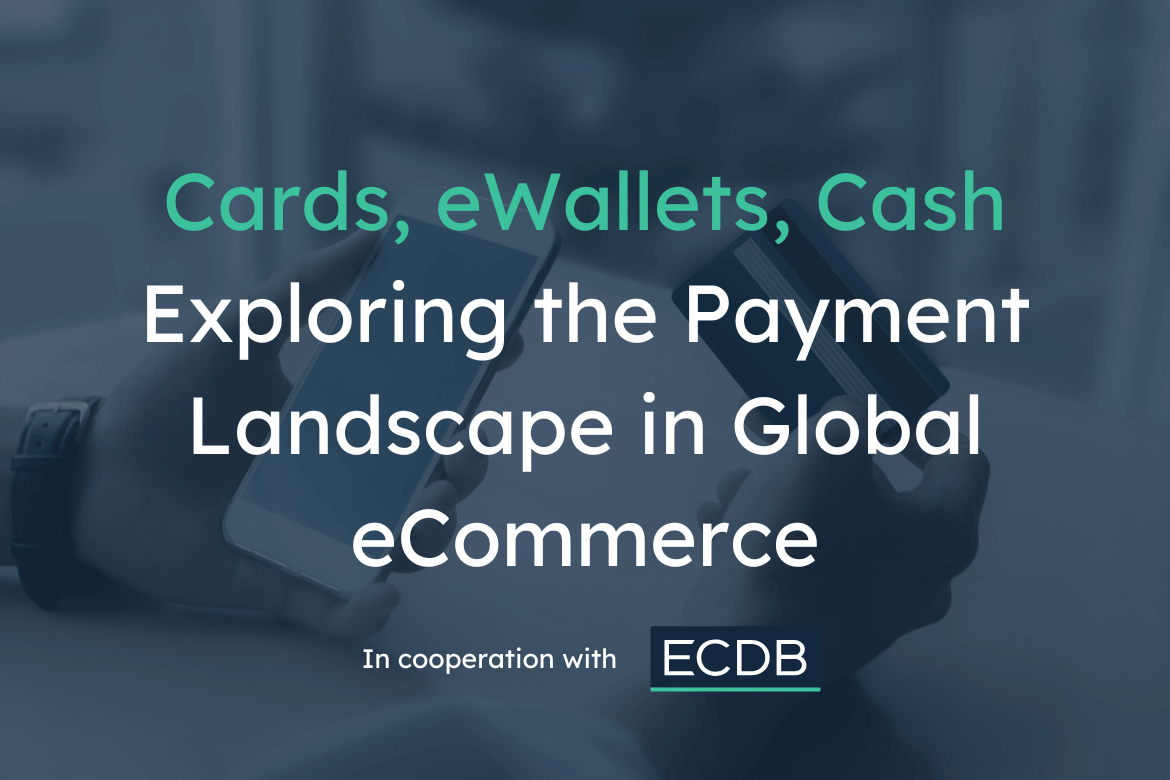One size doesn’t fit all: The role of payment options in cross-border eCommerce
Written by
Editorial TeamPublished on
From credit cards to cash-on-delivery and eWallets to BNPL, how shoppers pay online varies dramatically across the globe. ECDB’s latest analysis uncovers how regional payment preferences shape the eCommerce experience – and why a one-size-fits-all strategy could cost retailers conversions. (Ad)

Commercial collaboration
By Nadine Koutsou-Wehling, Data Journalist at ECDB
Payment providers play a substantial role in eCommerce. The selection of payment options influences the completion of orders and the likelihood of consumers making repeat purchases.
Despite the international nature of online shopping, payment preferences vary from country to country. While card payments dominate most markets, this is not true everywhere.
Some regions are quickly adopting digital solutions and installment payments. In others, the idea that cash is obsolete in eCommerce is far from the truth.
Explore the payment landscape in global eCommerce through the lens of ECDB’s rich data intelligence.
Payment provider diversity: Japan highest, China among lowest
First, consider the global diversity of payment options. The average number of payment providers that online stores offer varies from market to market.

Japan stands out with the greatest variety of payment methods. Online stores there offer an average of 9.5 payment methods, with cards being the most common.
Brazil and India fall into the second tier of markets with a high average number of payment methods in eCommerce. Brazil approaches 8, while in India online stores offer an average 7.5 payment methods.
The most common average is between 6 and 7 providers, as is the case in many European countries.
Greater China: A special case with less variety
China is at the lower end of the spectrum, with an average of only 4.1 payment providers in eCommerce. China’s eCommerce payment landscape is centralized and digital. The top two providers belong to the eWallet category. Alipay is the most widely accepted, with an online store penetration rate of 57.6%, followed by WeChat at 45.3%.
VISA and Mastercard are mostly accepted through integration with either eWallet, though large retailers enable direct use. In the rest of the world, online stores tend to offer the two credit card providers most often.
Credit cards are widely adopted in world eCommerce
Germany is an unusual case in that PayPal, rather than Mastercard or VISA, is the most widely offered payment provider in eCommerce. PayPal is adopted by 92% of online stores in Germany.

In other key markets, usage of both Mastercard and VISA is most common. That is the case for Australia, Spain, the UK, France, and the U.S., as shown in the chart. But the credit card lead extends itself across a wider range of markets outside of those mentioned above.
Online stores most frequently offer both Mastercard and VISA. The one percentage difference observed in some of the displayed markets stems from rounding and practically involves very few out of thousands of online stores.
PayPal is the most frequently used eWallet
PayPal is one of the most popular eWallets out there. Its easy integration with bank accounts and cards, as well as its growing number of payments services, makes it convenient for retailers and consumers to use.
Compared to traditional credit cards, PayPal’s use mostly falls short. In contrast to other eWallets, however, PayPal is the most frequently adopted. PayPal is offered by up to 85% in key markets, most of which are located in Europe.
Among the other eWallet providers, preference follows regional trends. Two of the largest are highly dependent on device usage.
Other eWallets on display: Apple Pay vs Google Pay
Following PayPal’s success, other providers came up with a similar concept. Two of the most prevalent companies are Google and Apple. They expanded their offerings to include fintech services with Google Pay and Apple Pay.

Across Europe, Apple Pay is the more popular of the two. While the two tech giants are head-to-head in terms of device and operating system popularity, more online stores on the continent offer Apple’s payment method.
That is, with the exception of select countries in Central and Southern Europe. More precisely, Poland, Bulgaria, Croatia, Ukraine and Greece are the five outliers where more online stores offer Google Pay than Apple Pay.
In Lithuania and Estonia, the number of stores offering Apple Pay and Google Pay is equal. Both countries have relatively small eCommerce markets, where online payments are not as prevalent as in larger industries. Therefore, the few stores that do offer Apple Pay also offer Google Pay, and vice versa.
BNPL: A modern trend with a clear winner
Among digital solutions for contemporary online shopper problems, “buy now, pay later” (BNPL) is a notable one. Fintech companies have established an accessible way for consumers to manage online purchases conveniently: This includes payment by installment or invoice, as well as a guaranteed reimbursement for retailers in case of default.

Given the BNPL boom over the past few years, a multitude of providers now offer the service. Klarna is the most widely adopted, while others, like Afterpay, struggle to gain a competitive advantage.
Provider usage also depends on the main category an online store offers. Klarna dominates across categories, but the race is tighter between Afterpay and PayPal.
Cash on delivery: A gradient divides Europe in its usage
On the other side of the spectrum are cash-based payments. Where a high share of eWallets typically points to mature digitalization and high consumer trust in new tech, other markets have more distinct preferences. Cash-on-Delivery (CoD) represents a divide in Europe.

The share of online stores that offer CoD in each European eCommerce market reveals three categories: Those where over 60% of online stores offer cash payments; those where less than 10% offer CoD; and those in between.
Scandinavian and Western to Northern European markets tend to offer CoD at a percentage below 10% in eCommerce. Given the generally high penetration of card payments in everyday life outside eCommerce in markets like Sweden, Norway, and the UK, CoD has an even smaller significance in online shopping.
Cash usage can also be a hack for speedier delivery
Markets with CoD penetration over 60% reveal different market structures and preferences. The countries over that threshold include Poland (60.7%), Lithuania (64.9%) and Serbia (69.2%).
Greece is the clear winner in terms of CoD usage in Europe, with 85.6% of online stores offering it. Besides the digital connectivity requirements of online stores and the regulatory framework that goes along with it, CoD penetration can also be a matter of delivery preference.
Because CoD payments are given priority by Greek courier companies to collect the cash and receive their pay accordingly, shoppers prefer the speed of delivery and the safety that goes with paying only for what they have collected.
Wrapping up the payments discussion
The international payments landscape is anything but uniform. While card payments are the norm in most markets, it makes sense to consider local preferences and regulations before adopting a one-size-fits-all approach.
Some markets have a high variety of payment options in eCommerce, such as Japan, Brazil, and India, while others are more centralized but digital, like China. PayPal is an U.S. company, but its penetration is not particularly high in its domestic market, it thrives in Europe more. Germany is the market where PayPal is the safest bet for eCommerce payments.
BNPL and no-cash payments are most prevalent in Scandinavia and Northern to Western Europe. Cash payments are part of everyday online business in Central to Southern Europe. Digital maturity is not always the deciding factor; it’s about knowing what works where and why.
***


